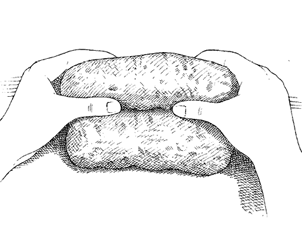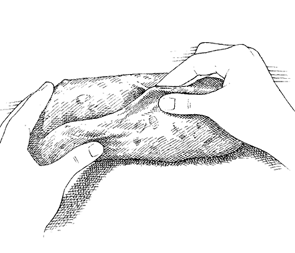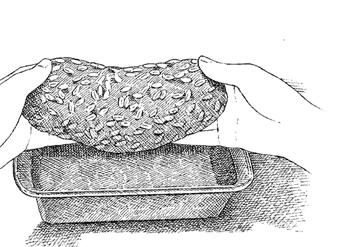The Cook's Illustrated Cookbook (272 page)
Read The Cook's Illustrated Cookbook Online
Authors: The Editors at America's Test Kitchen
Tags: #Cooking

Slide greased rubber spatula or bowl scraper under 1 side of dough; gently lift and fold edge of dough toward middle. Repeat folding as directed in recipe.


![]() WHY THIS RECIPE WORKS
WHY THIS RECIPE WORKS
Often multigrain bread either has great flavor but is as dense and as heavy as a brick, or it has a nice, light sandwich-style texture but so little grain it might as well be white bread. We wanted a multigrain bread with both great flavor and balanced texture. Early tests showed that the whole grains impede the development of gluten, the protein that gives baked goods structure. Bread flour, with its high protein content, would seem the ideal candidate to combat this problem, but we found that it only made the bread chewier, not less dense. We switched to all-purpose flour and came up with a twofold solution: an autolyse, a resting period that gives the flour time to hydrate, followed by long kneading. The result was a loaf that baked up light yet chewy without being tough. For the whole grains, we hit upon a convenient, one-stop-shopping alternative: packaged seven-grain hot cereal. To soften the grains, we made a thick porridge with the cereal before adding it to the dough. A final step of rolling the shaped loaves in oats yielded a finished, professional look.
See “SHAPING SANDWICH BREAD” illustrations that follow recipe.
MAKES TWO 9-INCH LOAVES
If you don’t have a stand mixer, you can mix the dough by hand following the instructions in
“TEST KITCHEN TIP NO. 119 HAND-MIXING METHOD FOR DOUGH”
. Don’t confuse seven-grain hot cereal mix with boxed cold breakfast cereals that may also be labeled “seven-grain.” Our favorite brands of seven-grain mix are Bob’s Red Mill and Arrowhead Mills. Do not substitute instant oats in this recipe. For an accurate measurement of boiling water, bring a full kettle of water to a boil, then measure out the desired amount.
1¹⁄ | cups (6¹⁄ |
2¹⁄ | cups boiling water |
3 | cups (15 ounces) all-purpose flour, plus extra as needed |
1¹⁄ | cups (8¹⁄ |
¹⁄ | cup honey |
4 | tablespoons unsalted butter, melted and cooled |
2¹⁄ | teaspoons instant or rapid-rise yeast |
1 | tablespoon salt |
³⁄ | cup unsalted pumpkin seeds or sunflower seeds |
¹⁄ | cup (1¹⁄ |
1.
Place cereal mix in bowl of stand mixer fitted with dough hook and pour boiling water over it; let stand, stirring occasionally, until mixture cools to 100 degrees and resembles thick porridge, about 1 hour. Whisk flours together in separate bowl.
2.
Once grain mixture has cooled, add honey, butter, and yeast and mix on low speed until combined. Add flour mixture, ¹⁄
2
cup at a time, and knead until cohesive mass starts to form, 1¹⁄
2
to 2 minutes; cover bowl tightly with plastic wrap and let dough rest for 20 minutes. Add salt and knead on medium-low speed until dough clears sides of bowl, 3 to 4 minutes (if it does not clear sides, add 2 to 3 tablespoons additional all-purpose flour and knead until it does); continue to knead dough for 5 more minutes. Add seeds and knead for another 15 seconds. Transfer dough to lightly floured counter and knead by hand until seeds are dispersed evenly and dough forms smooth, round ball. Place dough in large, lightly greased bowl; cover tightly with plastic and let rise at room temperature until nearly doubled in size, 45 minutes to 1 hour.
3.
Grease two 9 by 5-inch loaf pans. Transfer dough to lightly floured counter and divide in half. Press 1 piece of dough into 9 by 6-inch rectangle, with short side facing you. Roll dough toward you into firm cylinder, keeping roll taut by tucking it under itself as you go. Turn loaf seam side up and pinch it closed. Repeat with second piece of dough. Spray loaves lightly with water or vegetable oil spray. Roll each loaf in oats to coat evenly and place seam side down in prepared pans, pressing gently into corners. Cover loaves loosely with greased plastic and let rise at room temperature until nearly doubled in size, 30 to 40 minutes. (Dough should barely spring back when poked with knuckle.)
4.
Thirty minutes before baking, adjust oven rack to middle position and heat oven to 375 degrees. Bake until loaves register 200 degrees, 35 to 40 minutes. Transfer pans to wire rack and let cool for 5 minutes. Remove loaves from pans, return to rack, and let cool to room temperature, about 2 hours, before slicing and serving. (Bread can be wrapped in double layer of plastic wrap and stored at room temperature for up to 3 days. Wrapped with additional layer of aluminum foil, bread can be frozen for up to 1 month.)
MAKES 18 ROLLS
This recipe also works with a 13 by 9-inch baking dish.
1.
After dough has nearly doubled in size in step 2, grease two 9-inch square baking dishes. Transfer dough to lightly floured counter and divide in half. Cut each half into thirds, then into thirds again, to make 18 equal pieces of dough. Loosely cup hand around each piece of dough (not directly over it) and, without applying pressure, move hand in small circular motions to form smooth, taut round, then roll 1 side of ball in oats. Arrange 9 rolls in each prepared baking dish, cover lightly with greased plastic wrap, and let rise until nearly doubled in size, 30 to 40 minutes. (Dough should barely spring back when poked with knuckle.)
2.
Thirty minutes before baking, adjust oven rack to middle position and heat oven to 375 degrees. Bake until rolls register 200 degrees, 30 to 35 minutes. Transfer dishes to wire rack and let cool for 5 minutes. Remove rolls from dishes, return to rack, and let cool to room temperature, about 2 hours, before serving.
This shaping method works well for Multigrain Bread as well as our other sandwich breads in this chapter.

1.
Starting at farthest end, roll dough piece into log. Keep roll taut by tucking it under itself as you go.

2.
To seal loaf, pinch seam gently with thumb and forefinger.

3.
Place loaf seam side down in greased loaf pan, pressing gently into corners.
![]() WHY THIS RECIPE WORKS
WHY THIS RECIPE WORKS
Despite its forgiving nature, this bread can pose some problems. There are often gaps between the swirls of cinnamon filling and the bread, or the filling leaks out and burns in the pan. We wanted our bread to be moist and light but also firm enough to be sliced fresh. And while we were at it, we decided to develop a technique for ever-popular cinnamon rolls. To achieve the best texture and crust, we knew we needed to nail down the baking time and temperature as well as fine-tune the ingredients. For the dough, a compromise between rich brioche and lean sandwich bread yielded the best results. We found that brown sugar melted more readily and leaked through the dough, so we swapped it for white sugar. Pinching the loaf edges together tightly prevented the filling from leaking. Finally, we brushed the top of the loaf with an egg wash for a deep, shiny color before baking.
